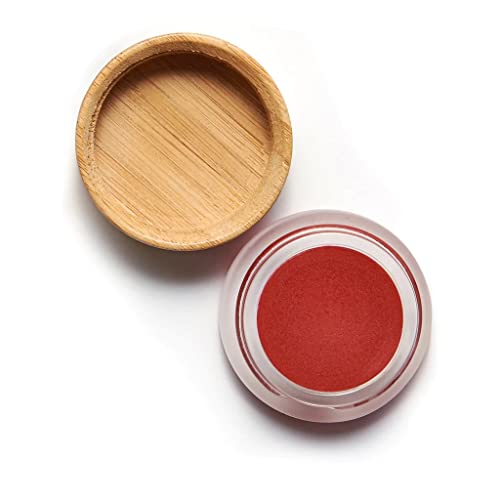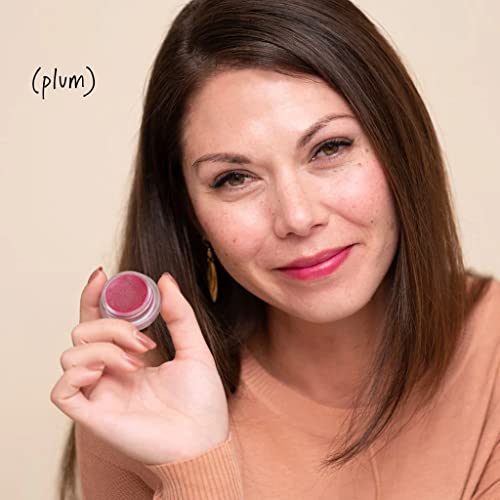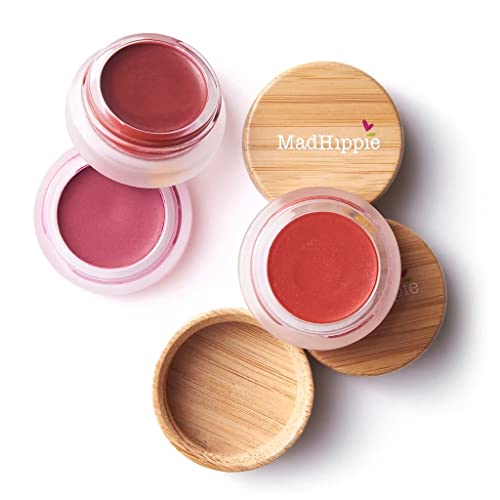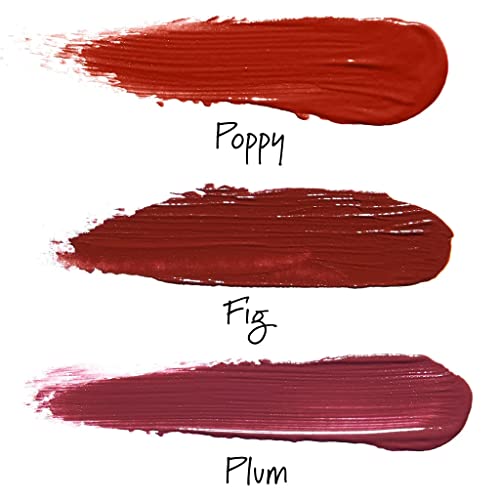





Mad Hippie Lip & Cheek Stain - Natural Color Boost, Cruelty-Free Formula - 0.24 oz


Ricinus Communis (Castor) Seed Oil
Medium RiskCastor oil is extracted from the seeds of Ricinus communis and is commonly used in cosmetic and personal care products for its moisturizing and emollient properties. It is known for its ability to enhance skin absorption and provide a protective barrier.
Sustai Insights
Castor oil offers functional benefits as a moisturizer and emollient, enhancing skin absorption and providing a barrier against moisture loss. It is sustainably sourced and biodegradable. However, potential health risks include low levels of irritation and moderate concerns regarding developmental and reproductive toxicity. Environmental risks are low, with no significant pollutant or bioaccumulation concerns reported. Regulatory status shows no current restrictions. Overall, the risk level is assessed as medium, with recommendations for safe usage practices, and potential alternatives include other plant-based oils.
Vaccinium Angustifolium (Blueberry) Fruit Extract
Low RiskVaccinium angustifolium (blueberry) fruit extract is derived from the fruit of the blueberry plant. It is commonly used in cosmetic and skincare products for its antioxidant properties and is believed to help protect the skin from oxidative stress.
Sustai Insights
Vaccinium angustifolium (blueberry) fruit extract offers functional benefits as an antioxidant, potentially assisting in skin protection. It is sustainably sourced and poses low health risks, with no significant concerns regarding carcinogenicity, allergies, or reproductive toxicity. Environmentally, it does not contribute to pollution or bioaccumulation. Regulatory bodies have not issued warnings against its use, indicating a low overall risk level. Safe usage practices should be followed, and alternatives include other fruit extracts with similar benefits. Overall, this ingredient is assessed as low risk.
Polyhydroxystearic Acid
Low RiskPolyhydroxystearic acid is a polymer of hydroxystearic acid, commonly used as an emulsifier and stabilizer in various cosmetic and personal care formulations. It enhances texture and consistency, facilitating the blending of water and oil-based components.
Sustai Insights
Polyhydroxystearic acid functions effectively as an emulsifier, contributing to product stability and texture. It is considered low risk for health concerns such as carcinogenicity, allergies, and developmental toxicity. Environmental assessments indicate minimal pollution and bioaccumulation potential. Regulatory bodies report no current restrictions on its use. Safe usage practices should be followed, although sensitive individuals may experience irritation. Overall, the ingredient is assessed to have a low risk.
Mica
Low RiskMica is a type of highly brittle silicate mineral commonly used in cosmetics and personal care products for its reflective properties and texture. It serves primarily as a colorant and opacifying agent, enhancing the aesthetic appeal of formulations.
Sustai Insights
Mica provides functional benefits such as adding shimmer and improving the texture of cosmetics. It is generally considered low risk concerning health concerns like carcinogenicity and allergenic potential. However, there are risks associated with its persistence and potential for bioaccumulation in the environment. Regulatory bodies have noted some restrictions on mica sourcing due to ethical concerns surrounding mining practices. Overall, while mica has low health risks, its environmental impact necessitates careful sourcing and consideration of alternatives like synthetic colorants or other natural minerals.
Corn Starch, Modified
Low RiskModified corn starch is a calcium salt derived from corn starch, commonly used as a thickening agent or stabilizer in various cosmetic formulations. It enhances product texture and consistency without imparting significant color or odor.
Sustai Insights
Modified corn starch offers functional benefits as a thickener and stabilizer in cosmetic products, with low allergenic potential and minimal health risks, including low concerns for carcinogenicity and reproductive toxicity. Environmental risks appear low, with no significant pollutant potential or bioaccumulation identified. Regulatory status shows no major restrictions, though verified products must ensure compliance. Overall, the ingredient is assessed as low risk, suitable for use in various formulations, with no immediate alternatives necessary.
C10 18 Triglycerides
Low RiskC10-18 triglycerides are triesters of glycerin and fatty acids, primarily derived from natural sources. They function as emollients and skin-conditioning agents in cosmetic and personal care formulations, enhancing the texture and moisture content of products.
Sustai Insights
C10-18 triglycerides offer functional benefits as emollients, providing moisture and improving product texture. They are generally regarded as safe, with low concerns for carcinogenicity, allergenic potential, and reproductive toxicity. Environmental risks are minimal, as they are not known to be pollutants or bioaccumulative. Regulatory agencies do not impose significant restrictions on their use. Overall, the risk level is assessed as low, suggesting safe usage in products.
Copernicia Cerifera (Carnauba) Wax
Low RiskCopernicia cerifera (carnauba) wax is derived from the leaves of the carnauba palm, primarily found in Brazil. It acts as a natural thickening agent and emollient in cosmetic formulations, contributing to texture and stability in products such as creams, lip balms, and lotions.
Sustai Insights
Carnauba wax is valued for its functional benefits, including its effectiveness as a thickener and emollient, and is sourced sustainably, making it a biodegradable option. Health risks are minimal, with low concerns regarding carcinogenicity, allergies, or reproductive toxicity. Environmentally, it poses low risks regarding pollution or bioaccumulation. Regulatory bodies have not issued warnings, affirming its safety profile. Overall, the ingredient is assessed as low risk, with no significant adverse health or environmental impacts identified, making it a favorable choice in cosmetic formulations.
Hippophae Rhamnoides (Sea Buckthorn) Extract
Low RiskHippophae rhamnoides extract is derived from the sea buckthorn plant, known for its rich nutrient profile, including vitamins, fatty acids, and antioxidants. It is commonly used in cosmetic and personal care products for its potential skin benefits, such as hydration and nourishment.
Sustai Insights
Hippophae rhamnoides extract offers functional benefits like enhancing skin hydration and providing antioxidant properties. It is sustainably sourced and generally considered low risk for health concerns, including carcinogenicity and allergies. Environmental impacts are minimal, with no evidence of bioaccumulation or pollution. Regulatory bodies have not issued any significant warnings. Overall, the risk level associated with this ingredient is low, making it a suitable choice for various applications.
Ci 77499
Low RiskCI 77499, also known as iron oxides, are inorganic pigments commonly used in cosmetic products for their coloring properties. They provide a range of shades and are often included for their stability and opacity, enhancing the visual appeal of formulations.
Sustai Insights
CI 77499 offers functional benefits as a stable colorant, contributing to product aesthetics without significant health risks, as concerns for carcinogenicity, allergies, and reproductive toxicity are low. However, it has high persistence and bioaccumulation potential in the environment, raising ecotoxicity concerns. Regulatory restrictions exist for certain uses. Overall, the ingredient presents a low risk profile when used according to safety guidelines, with alternatives available for those seeking greener options.
Cetyl Alcohol
Low RiskCetyl alcohol is a long-chain organic alcohol commonly used in cosmetic formulations. It serves as an emollient, emulsifier, and thickening agent, enhancing the texture and stability of products. Cetyl alcohol is derived from natural sources, such as coconut or palm oil, and is often included in creams, lotions, and hair conditioners.
Sustai Insights
Cetyl alcohol offers functional benefits as an emollient and emulsifier, improving product texture and stability. It is biodegradable and sourced from renewable materials, contributing to sustainability. Health risks are minimal, with low concerns for carcinogenicity, allergies, or reproductive toxicity. Environmental impact is also low, with no significant pollutant or bioaccumulation potential. Regulatory bodies have not placed restrictions on its use, indicating a favorable safety profile. Overall, cetyl alcohol is assessed as low risk, and safe usage practices include ensuring proper formulation concentrations.
Cocos Nucifera (Coconut) Oil
Low RiskCocos Nucifera (Coconut) Oil is derived from the kernels of the coconut palm. It is primarily used in cosmetic formulations for its emollient and moisturizing properties, making it suitable for skin and hair care products.
Sustai Insights
Coconut oil serves as an effective moisturizer and emollient, promoting skin hydration and softness. It is sustainably sourced and biodegradable. Health risks are minimal, with low concerns regarding carcinogenicity, allergens, and reproductive toxicity. Environmental impact is also low, as it does not contribute significantly to pollution or bioaccumulation. Regulatory bodies have not issued restrictions on its use. Overall, coconut oil presents a low risk for health and environmental concerns, making it a safe ingredient in cosmetic products.
Butyrospermum Parkii (Shea) Butter
Low RiskButyrospermum parkii (shea) butter is a vegetable fat derived from the nuts of the shea tree. It is commonly used in cosmetic formulations for its emollient properties, providing moisture and improving skin texture. Additionally, shea butter is known for its ability to enhance the stability of products and deliver a creamy texture.
Sustai Insights
Shea butter offers functional benefits as an effective moisturizer, enhancing skin barrier function and texture. It is sustainably sourced and biodegradable, contributing to eco-friendliness. Health-wise, it is associated with low risks for carcinogenicity, allergies, and reproductive toxicity. Environmental impacts are minimal, with no significant pollutant potential identified. Regulatory assessments indicate no current restrictions. Overall, the ingredient presents a low risk, making it a favorable choice in cosmetic formulations.
Simmondsia Chinensis (Jojoba) Seed Oil
Low RiskSimmondsia chinensis (jojoba) seed oil is extracted from the seeds of the jojoba plant. It is commonly used in cosmetics for its moisturizing properties and ability to mimic human sebum, making it beneficial for skin and hair care formulations.
Sustai Insights
Jojoba seed oil offers functional benefits such as effective moisturization and emollience, contributing to skin hydration and smoothness. It is sustainably sourced and biodegradable. Health risks are low, with minimal concerns regarding carcinogenicity, allergies, and reproductive toxicity. Environmental risks are also low, as it does not significantly contribute to pollution or bioaccumulation. Currently, there are no regulatory restrictions on its use. Overall, the risk level is low, and it is considered a safe ingredient with no significant adverse effects.
Vaccinium Angustifolium (Blueberry) Fruit Extract
Low RiskVaccinium angustifolium (blueberry) fruit extract is derived from the fruit of the blueberry plant. It is commonly used in cosmetic and skincare products for its antioxidant properties and is believed to help protect the skin from oxidative stress.
Sustai Insights
Vaccinium angustifolium (blueberry) fruit extract offers functional benefits as an antioxidant, potentially assisting in skin protection. It is sustainably sourced and poses low health risks, with no significant concerns regarding carcinogenicity, allergies, or reproductive toxicity. Environmentally, it does not contribute to pollution or bioaccumulation. Regulatory bodies have not issued warnings against its use, indicating a low overall risk level. Safe usage practices should be followed, and alternatives include other fruit extracts with similar benefits. Overall, this ingredient is assessed as low risk.
Ricinus Communis (Castor) Seed Oil
Medium RiskCastor oil is extracted from the seeds of Ricinus communis and is commonly used in cosmetic and personal care products for its moisturizing and emollient properties. It is known for its ability to enhance skin absorption and provide a protective barrier.
Sustai Insights
Castor oil offers functional benefits as a moisturizer and emollient, enhancing skin absorption and providing a barrier against moisture loss. It is sustainably sourced and biodegradable. However, potential health risks include low levels of irritation and moderate concerns regarding developmental and reproductive toxicity. Environmental risks are low, with no significant pollutant or bioaccumulation concerns reported. Regulatory status shows no current restrictions. Overall, the risk level is assessed as medium, with recommendations for safe usage practices, and potential alternatives include other plant-based oils.
Polyhydroxystearic Acid
Low RiskPolyhydroxystearic acid is a polymer of hydroxystearic acid, commonly used as an emulsifier and stabilizer in various cosmetic and personal care formulations. It enhances texture and consistency, facilitating the blending of water and oil-based components.
Sustai Insights
Polyhydroxystearic acid functions effectively as an emulsifier, contributing to product stability and texture. It is considered low risk for health concerns such as carcinogenicity, allergies, and developmental toxicity. Environmental assessments indicate minimal pollution and bioaccumulation potential. Regulatory bodies report no current restrictions on its use. Safe usage practices should be followed, although sensitive individuals may experience irritation. Overall, the ingredient is assessed to have a low risk.
Mica
Low RiskMica is a type of highly brittle silicate mineral commonly used in cosmetics and personal care products for its reflective properties and texture. It serves primarily as a colorant and opacifying agent, enhancing the aesthetic appeal of formulations.
Sustai Insights
Mica provides functional benefits such as adding shimmer and improving the texture of cosmetics. It is generally considered low risk concerning health concerns like carcinogenicity and allergenic potential. However, there are risks associated with its persistence and potential for bioaccumulation in the environment. Regulatory bodies have noted some restrictions on mica sourcing due to ethical concerns surrounding mining practices. Overall, while mica has low health risks, its environmental impact necessitates careful sourcing and consideration of alternatives like synthetic colorants or other natural minerals.
Corn Starch, Modified
Low RiskModified corn starch is a calcium salt derived from corn starch, commonly used as a thickening agent or stabilizer in various cosmetic formulations. It enhances product texture and consistency without imparting significant color or odor.
Sustai Insights
Modified corn starch offers functional benefits as a thickener and stabilizer in cosmetic products, with low allergenic potential and minimal health risks, including low concerns for carcinogenicity and reproductive toxicity. Environmental risks appear low, with no significant pollutant potential or bioaccumulation identified. Regulatory status shows no major restrictions, though verified products must ensure compliance. Overall, the ingredient is assessed as low risk, suitable for use in various formulations, with no immediate alternatives necessary.
C10 18 Triglycerides
Low RiskC10-18 triglycerides are triesters of glycerin and fatty acids, primarily derived from natural sources. They function as emollients and skin-conditioning agents in cosmetic and personal care formulations, enhancing the texture and moisture content of products.
Sustai Insights
C10-18 triglycerides offer functional benefits as emollients, providing moisture and improving product texture. They are generally regarded as safe, with low concerns for carcinogenicity, allergenic potential, and reproductive toxicity. Environmental risks are minimal, as they are not known to be pollutants or bioaccumulative. Regulatory agencies do not impose significant restrictions on their use. Overall, the risk level is assessed as low, suggesting safe usage in products.
Copernicia Cerifera (Carnauba) Wax
Low RiskCopernicia cerifera (carnauba) wax is derived from the leaves of the carnauba palm, primarily found in Brazil. It acts as a natural thickening agent and emollient in cosmetic formulations, contributing to texture and stability in products such as creams, lip balms, and lotions.
Sustai Insights
Carnauba wax is valued for its functional benefits, including its effectiveness as a thickener and emollient, and is sourced sustainably, making it a biodegradable option. Health risks are minimal, with low concerns regarding carcinogenicity, allergies, or reproductive toxicity. Environmentally, it poses low risks regarding pollution or bioaccumulation. Regulatory bodies have not issued warnings, affirming its safety profile. Overall, the ingredient is assessed as low risk, with no significant adverse health or environmental impacts identified, making it a favorable choice in cosmetic formulations.
Hippophae Rhamnoides (Sea Buckthorn) Extract
Low RiskHippophae rhamnoides extract is derived from the sea buckthorn plant, known for its rich nutrient profile, including vitamins, fatty acids, and antioxidants. It is commonly used in cosmetic and personal care products for its potential skin benefits, such as hydration and nourishment.
Sustai Insights
Hippophae rhamnoides extract offers functional benefits like enhancing skin hydration and providing antioxidant properties. It is sustainably sourced and generally considered low risk for health concerns, including carcinogenicity and allergies. Environmental impacts are minimal, with no evidence of bioaccumulation or pollution. Regulatory bodies have not issued any significant warnings. Overall, the risk level associated with this ingredient is low, making it a suitable choice for various applications.
Ci 77499
Low RiskCI 77499, also known as iron oxides, are inorganic pigments commonly used in cosmetic products for their coloring properties. They provide a range of shades and are often included for their stability and opacity, enhancing the visual appeal of formulations.
Sustai Insights
CI 77499 offers functional benefits as a stable colorant, contributing to product aesthetics without significant health risks, as concerns for carcinogenicity, allergies, and reproductive toxicity are low. However, it has high persistence and bioaccumulation potential in the environment, raising ecotoxicity concerns. Regulatory restrictions exist for certain uses. Overall, the ingredient presents a low risk profile when used according to safety guidelines, with alternatives available for those seeking greener options.
Cetyl Alcohol
Low RiskCetyl alcohol is a long-chain organic alcohol commonly used in cosmetic formulations. It serves as an emollient, emulsifier, and thickening agent, enhancing the texture and stability of products. Cetyl alcohol is derived from natural sources, such as coconut or palm oil, and is often included in creams, lotions, and hair conditioners.
Sustai Insights
Cetyl alcohol offers functional benefits as an emollient and emulsifier, improving product texture and stability. It is biodegradable and sourced from renewable materials, contributing to sustainability. Health risks are minimal, with low concerns for carcinogenicity, allergies, or reproductive toxicity. Environmental impact is also low, with no significant pollutant or bioaccumulation potential. Regulatory bodies have not placed restrictions on its use, indicating a favorable safety profile. Overall, cetyl alcohol is assessed as low risk, and safe usage practices include ensuring proper formulation concentrations.
Cocos Nucifera (Coconut) Oil
Low RiskCocos Nucifera (Coconut) Oil is derived from the kernels of the coconut palm. It is primarily used in cosmetic formulations for its emollient and moisturizing properties, making it suitable for skin and hair care products.
Sustai Insights
Coconut oil serves as an effective moisturizer and emollient, promoting skin hydration and softness. It is sustainably sourced and biodegradable. Health risks are minimal, with low concerns regarding carcinogenicity, allergens, and reproductive toxicity. Environmental impact is also low, as it does not contribute significantly to pollution or bioaccumulation. Regulatory bodies have not issued restrictions on its use. Overall, coconut oil presents a low risk for health and environmental concerns, making it a safe ingredient in cosmetic products.
Butyrospermum Parkii (Shea) Butter
Low RiskButyrospermum parkii (shea) butter is a vegetable fat derived from the nuts of the shea tree. It is commonly used in cosmetic formulations for its emollient properties, providing moisture and improving skin texture. Additionally, shea butter is known for its ability to enhance the stability of products and deliver a creamy texture.
Sustai Insights
Shea butter offers functional benefits as an effective moisturizer, enhancing skin barrier function and texture. It is sustainably sourced and biodegradable, contributing to eco-friendliness. Health-wise, it is associated with low risks for carcinogenicity, allergies, and reproductive toxicity. Environmental impacts are minimal, with no significant pollutant potential identified. Regulatory assessments indicate no current restrictions. Overall, the ingredient presents a low risk, making it a favorable choice in cosmetic formulations.
Simmondsia Chinensis (Jojoba) Seed Oil
Low RiskSimmondsia chinensis (jojoba) seed oil is extracted from the seeds of the jojoba plant. It is commonly used in cosmetics for its moisturizing properties and ability to mimic human sebum, making it beneficial for skin and hair care formulations.
Sustai Insights
Jojoba seed oil offers functional benefits such as effective moisturization and emollience, contributing to skin hydration and smoothness. It is sustainably sourced and biodegradable. Health risks are low, with minimal concerns regarding carcinogenicity, allergies, and reproductive toxicity. Environmental risks are also low, as it does not significantly contribute to pollution or bioaccumulation. Currently, there are no regulatory restrictions on its use. Overall, the risk level is low, and it is considered a safe ingredient with no significant adverse effects.
Elevate your natural beauty with the Mad Hippie Skin Care Cheek and Lip Poppy! This versatile lip and cheek stain offers a radiant flush that enhances your features while caring for your skin. Crafted with nourishing ingredients, it's the perfect choice for the environmentally conscious consumer.
- Nourishing Ingredients: Enriched with coconut oil, shea butter, and jojoba oil for hydration and skin-loving benefits.
- Clean Beauty: Free from silicones, parabens, and synthetic dyes, ensuring a safe, gentle application for all skin types.
- Buildable Coverage: Easily layer the tint for a soft glow or a bolder, vibrant look that lasts throughout the day.
- Easy Application: Perfect for on-the-go touch-ups, simply apply with your fingers or a brush for a seamless finish.
- Eco-Friendly Mission: Mad Hippie is committed to sustainable practices, making this product a choice you can feel good about for both your health and the planet.
Subscribe & Save with Sustai
- Best Price Guarantee: Always enjoy the lowest prices on sustainable home essentials.
- No Surprises: We’ll notify you before shipping. No hidden fees, ever.
- You’re in Charge: Change, pause, or cancel your subscription anytime with ease.
- Eco-Friendly Deliveries: Our grouped shipments mean less packaging and lower emissions.
Join us on a sustainable journey. Special offers for a limited time! Prices and promotions may change.
Recommended Products
Elevate your natural beauty with the Mad Hippie Skin Care Cheek and Lip Poppy! This versatile lip and cheek stain offers a radiant flush that enhances your features while caring for your skin. Crafted with nourishing ingredients, it's the perfect choice for the environmentally conscious consumer.
- Nourishing Ingredients: Enriched with coconut oil, shea butter, and jojoba oil for hydration and skin-loving benefits.
- Clean Beauty: Free from silicones, parabens, and synthetic dyes, ensuring a safe, gentle application for all skin types.
- Buildable Coverage: Easily layer the tint for a soft glow or a bolder, vibrant look that lasts throughout the day.
- Easy Application: Perfect for on-the-go touch-ups, simply apply with your fingers or a brush for a seamless finish.
- Eco-Friendly Mission: Mad Hippie is committed to sustainable practices, making this product a choice you can feel good about for both your health and the planet.

You can have at most 2 Sustainable Steals products in your cart
Customer Reviews
Customers’ View
Customers appreciate the versatility and natural appearance of the Cheek and Lip Tint, noting its effectiveness for both cheeks and lips. Many users commend its nourishing ingredients, which include coconut oil and shea butter, contributing to a hydrating and skin-friendly experience. Positive feedback highlights the product's smooth texture that allows for easy application and blending, making it suitable for quick touch-ups. While there are mentions of uneven pigmentation by some users, the overall sentiment reflects satisfaction with the vibrant color payoff and eco-friendly packaging. Overall, customers find this product to be a valuable addition to their beauty routine, aligning well with their health-conscious and environmentally friendly values.
AI-generated from the text of customer reviewsThis product has no reviews yet.




